Day 1 of a two day weekend of Bird Tours. Today was to be spent on the North Norfolk coast looking for lingering winter visitors and any early spring migrants. The weather was meant to be grey and cloudy, perhaps misty, with a chance of light rain. It was certainly the former, though we missed the latter, and we did even have a bit of sunshine at one point instead!
The winter thrushes are on the move at the moment, starting to make their way back north. On our drive down towards the coast, we saw a large flock of Redwings come up out of the trees in one of the river valleys. A pair of Stock Doves were displaying over some old barns, hopefully a sign that spring is on its way. A pair of Bullfinches flew across the road, flashing their white rumps.
Our first stop was at Cley. We planned to have a walk up along the East Bank and see if any more birds were moving along the coast today. There were plenty of geese and ducks still out on the grazing marshes – the Wigeon, Teal and Brent Geese will all be leaving us soon, but the Greylags and Shelduck may stay to breed here.
A Marsh Harrier circled up distantly over Pope’s Marsh but we got nice views of a second one perched in a bush in the middle of the reedbed, a rather pale female. When we heard ‘pinging’ calls from the reeds along the ditch just below the bank, we looked down to see several Bearded Tits edging up the stems.
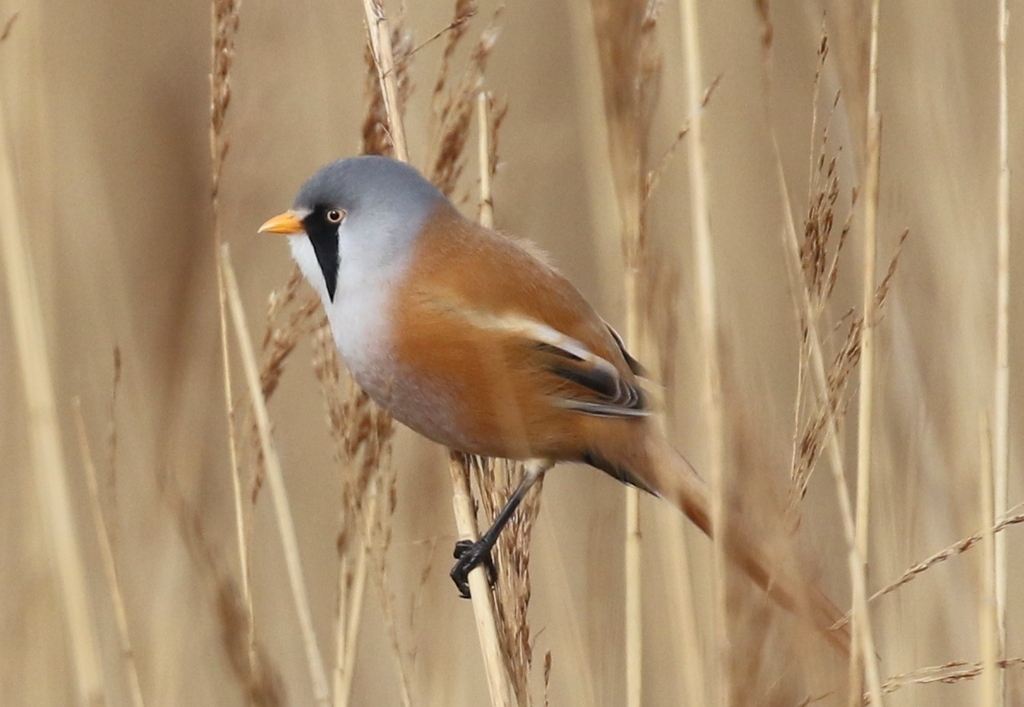
It was a lovely still morning, so the Bearded Tits put on a great performance for us. They would drop down deeper into the reeds but repeatedly climbed up again and perched in the tops giving fantastic views. There were at least six of them, including several smart males with powder grey heads and black moustaches. They are neither really bearded, nor actual tits – Moustachioed Reedling would perhaps be a better name!
They are great to watch as they clamber around in the reeds. Bearded Tits’ legs can stretch in all directions to cling on to the stems – they must be triple jointed!
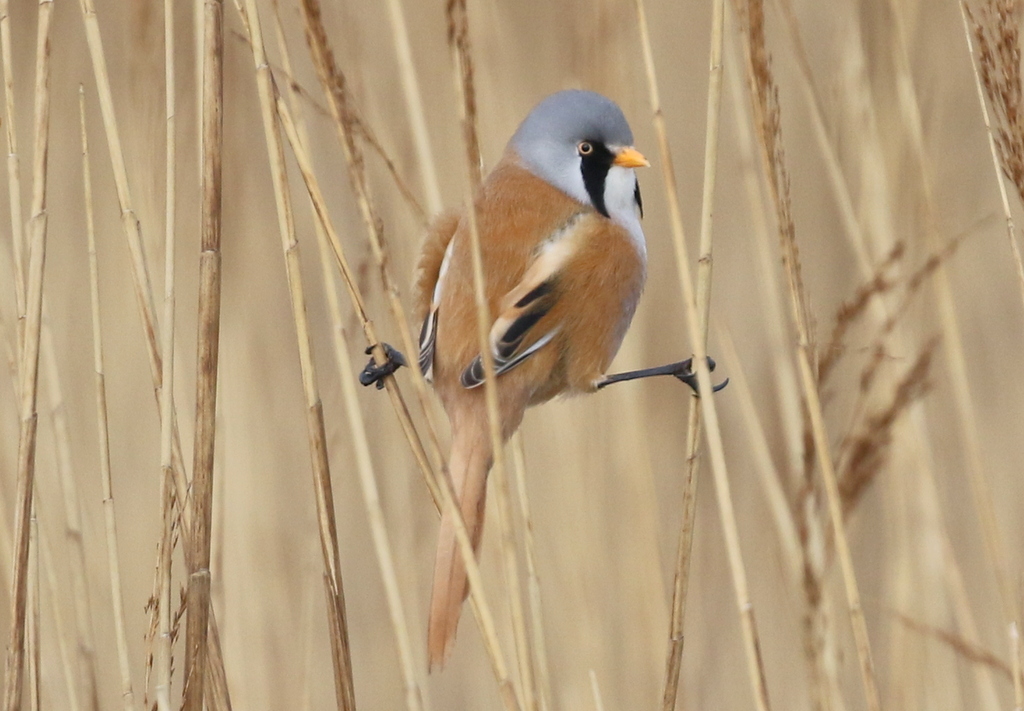
There were a few waders on the muddy margins of the pools on the grazing marsh. A couple of Ringed Plovers were accompanied by two Dunlin out on a more open area. Two Common Snipe were busy probing in the mud along one of the grassier edges. A group of five Black-tailed Godwits flew in from the pools by the hides and over our heads, flashing their black and white wings. A couple of Ruff dropped in at the back, on Pope’s Pool, where we had a look at them in the scope. They are not yet getting their elaborate neck ‘ruffs’.
Avocet numbers are really building up now, ahead of the breeding season, and there were quite a few on Pope’s Pool today. The Redshank are already starting to display, calling and song flighting. When a flock of Lapwings flew in and dropped down onto the grazing marshes, it seemed to prompt one or two of the locals to start to display. We stood and watched an impressive performance from one Lapwing which twisted and tumbled in front of us over the edge of the reedbed.

There were lots more waders out on Arnold’s Marsh, where the water level has dropped nicely. We could see lots of Dunlin in the shallow water, along with a good number of Redshank, a few Curlew and more Avocets. Two Oystercatchers were asleep at the front. Scanning through carefully, we found two Turnstones on one of the gravel spits busy turning stones over and a couple of Grey Plover, still in grey non-breeding plumage.
On the brackish pools the other side of the path, we found out first Little Egret of the day. A smart pair of Pintail were busy upending out in the middle of the water nearby. A Curlew was catching the morning light. Further up, behind the beach, a couple of Meadow Pipits were busy displaying, fluttering up and parachuting down, though one of them had the sound turned off!

There was no sign of any migrants moving along the coast today, despite the mild weather. The sea was very calm and very quiet too, although it was a bit misty still looking out over the water. We decided to head back – with a smart male Reed Bunting perched up in the top of the reeds distracting us briefly on the way.
As we got back to the road, we were told that a Spoonbill was on the pool from Babcock Hide, so we walked round to have a look. A quick scan from the path, and we could see it was fast asleep at the back, behind a line of reeds, so we didn’t stop at the hide.
Our next destination was Holkham. As we drove up along Lady Anne’s Drive, we stopped to look at a pair of Egyptian Geese out on the grass. We noticed a Common Buzzard was on the ground nearby, busy ripping into something it had presumably just killed. The Egyptian Geese walked straight past it, as did a pair of Greylags approaching from the opposite direction. A little further on, we spotted a pair of Grey Partridge in the grass on the edge of one of the ditches.
Parking at the top of Lady Anne’s Drive, there were lots of Wigeon out on the grazing marshes still, busy feeding on the grass accompanied by a few Black-tailed Godwits and Curlews. A lone Brent Goose was out on the meadow the other side, presumably a sick or injured bird which has been left behind by the flock. Several Marsh Harriers were quartering in the distance.
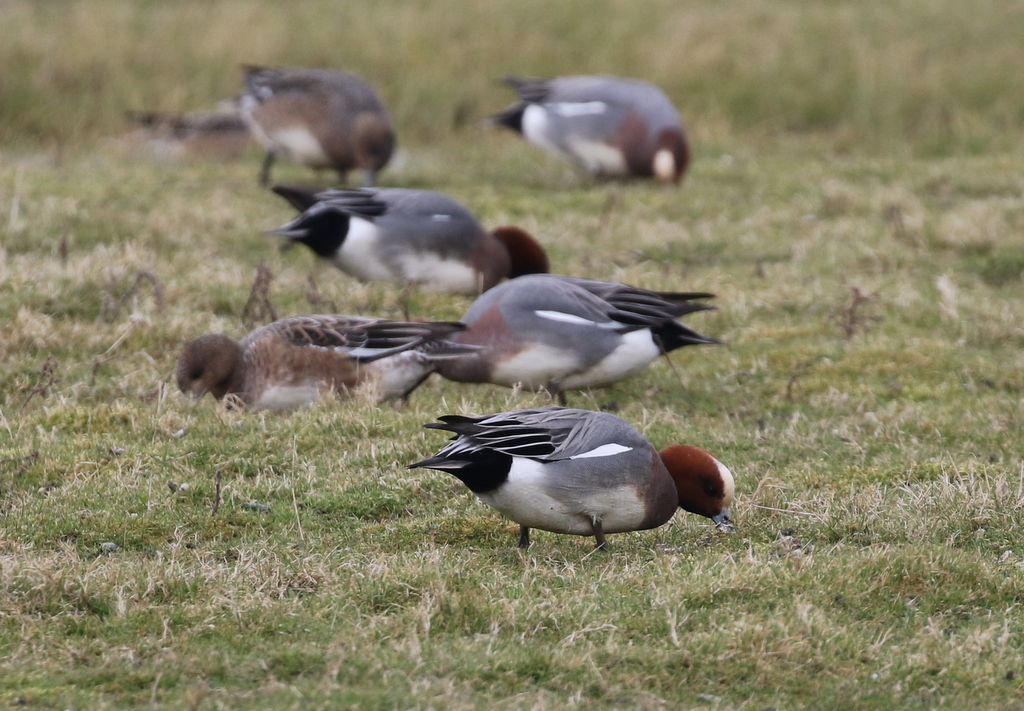
We headed out towards the beach first, turning east along the edge of the saltmarsh. There were lots of people here today and dogs running around everywhere we went. A couple of Skylarks were singing overhead, but there was no sign of the Shorelarks today. Everywhere we went to look for them, we found people clambering in the dunes or dogs running around, but it may be that they have departed already. A Woodcock was a nice bonus from our walk out here. Presumably flushed from somewhere deep in the trees, it flew across the north edge of the pines before cutting back in further along.
When we got back to Lady Anne’s Drive, it was time for lunch, so we made good use of the picnic tables and enjoyed the view. We watched a Great White Egret fly in from away to the west and it appeared to land in front of Washington Hide, so we made our way over that way after we had eaten.
The trees were pretty quiet at first – not even a Chiffchaff in and singing yet. At Salt’s Hole a Little Grebe was hiding in the reeds and a female Tufted Duck was asleep. A Treecreeper was singing nearby. Further along, we found some Goldcrests and Coal Tits in the holm oaks and eventually came across a flock of mostly Long-tailed Tits, although they shot through very quickly into the pines.
There was no sign of the Great White Egret now on the pool in front of Washington Hide – just a few more Tufted Ducks and a lone female Common Pochard – so we carried straight on to Joe Jordan Hide. Unfortunately there were several people in there already, who had spread themselves out or were eating their lunch, so there wasn’t a lot of room for us.
There were a few geese feeding on the grass on the old fort, so we got them in the scope. Most of the Pink-footed Geese have gone back north already, so it was nice to see about 15 here, although their pink feet were hard to see in the long grass! Four (Russian) White-fronted Geese were feeding nearby, but flew off back over the trees before everyone had a chance to see them through the scope. Thankfully we found another flock of about thirty down in the wet grass away to the right of the hide, and we had a good look at them, admiring their white fronts and blackish belly bars.

We managed to get better views of a Great White Egret here, standing in a reedy ditch in front of the hide, and some Spoonbills which weren’t asleep! At first, we spotted a Spoonbill further over, feeding on one of the pools, busy sweeping its bill from side to side. One or two were flying round in and out of the trees, then two more Spoonbills appeared on the large pool in front of the hide where we got a much better look at them through the scope.
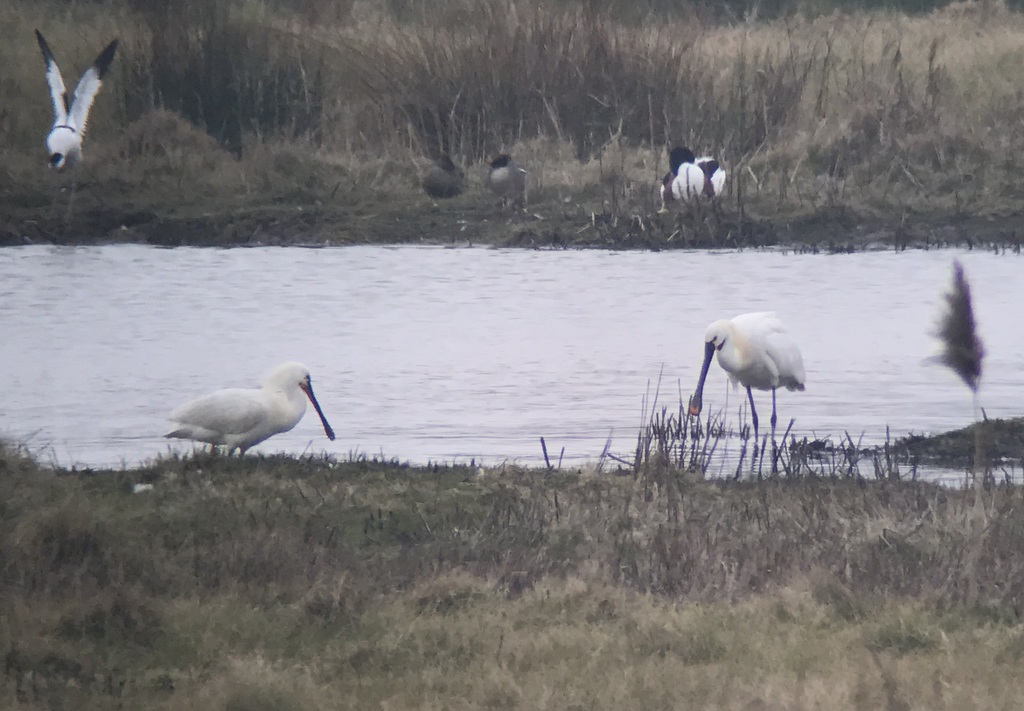
As we couldn’t all fit in on the benches in the hide, we decided to head back once we had all had a good look at the main species we had come to see here. Once back at the car, we made our way further west along the coast road to Titchwell.
Making our way from the car park towards the visitor centre, we could hear Bramblings singing in the bushes. It is not much of a song, more of a wheeze! The more we looked, the more we realised we could see, and we stopped to admire several of them, including a smart male Brambling which was busy feeding on the buds of the sallows.
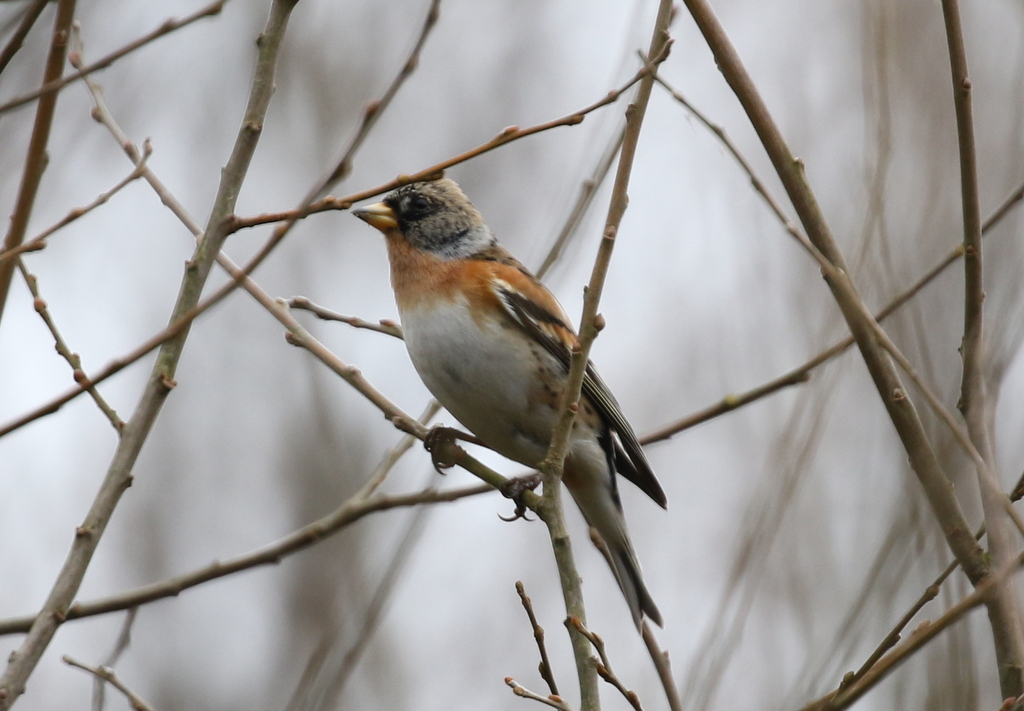
Most of the birds were in the bushes and trees today, and there was not much more on the feeders, apart from lots of Chaffinches. As we headed out towards the reserve, a quick scan of the ditches was rewarded with a Water Rail which gave very nice views, picking around in the leaf litter in the bottom.
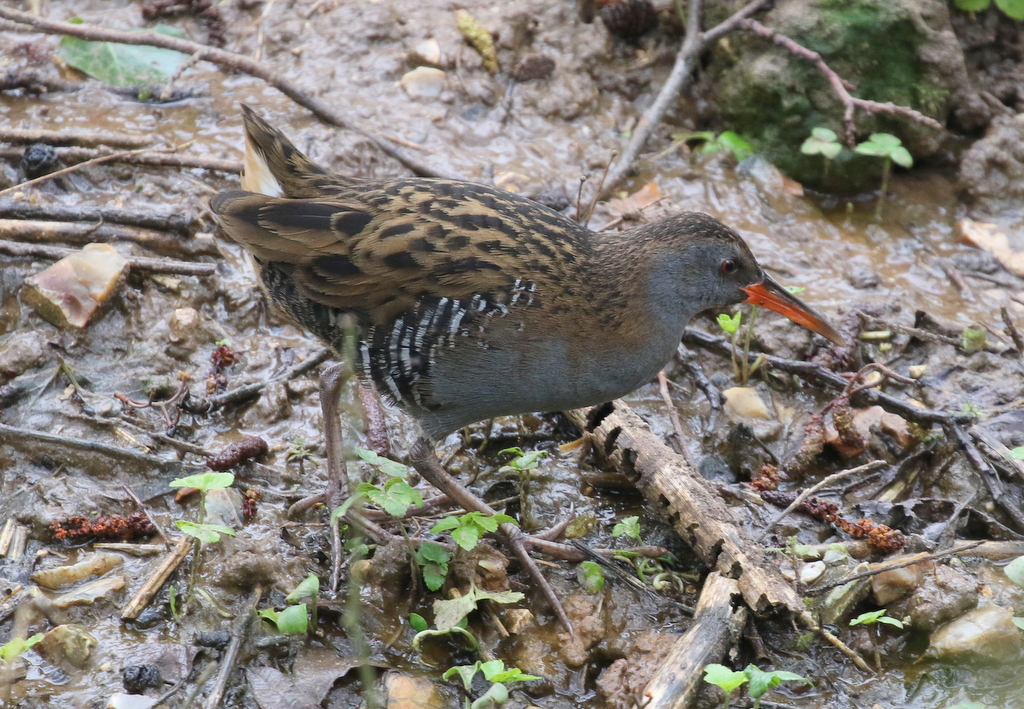
The Thornham grazing marsh ‘pool’ looked very quiet at first, but a careful scan was eventually rewarded. Several Pied Wagtails were feeding in and out of the vegetation right at the back, and a Water Pipit appeared nearby. It wasn’t easy to see though, and kept disappearing back into cover.
The reedbed pool held a few Tufted Ducks and Common Pochard diving out in the middle among the Greylags. On the near edge of the reedbed, a pair of Bearded Tits were feeding at the base of the reeds around the small pools, delighting the crowd gathered, although we had been spoilt with our views of Bearded Tits earlier this morning.
The water levels of the freshmarsh are still very high – they don’t seem to have come down at all, despite the drier weather recently. Consequently, there are next to no waders on here still. The fenced-off island where the Avocets are supposed to nest has been almost completely taken over by gulls.
At least it seems to be appreciated by the Mediterranean Gulls, with at least 60 being seen around the reserve at the moment. We could hear them calling almost constantly as we walked out. Pairs were flying back and forth, in and out of the freshmarsh, flashing their pure white wing tips. We had great views of a stunning adult Mediterranean Gull which had landed in the shallow water quite close to the path with a group of Black-headed Gulls to bathe.
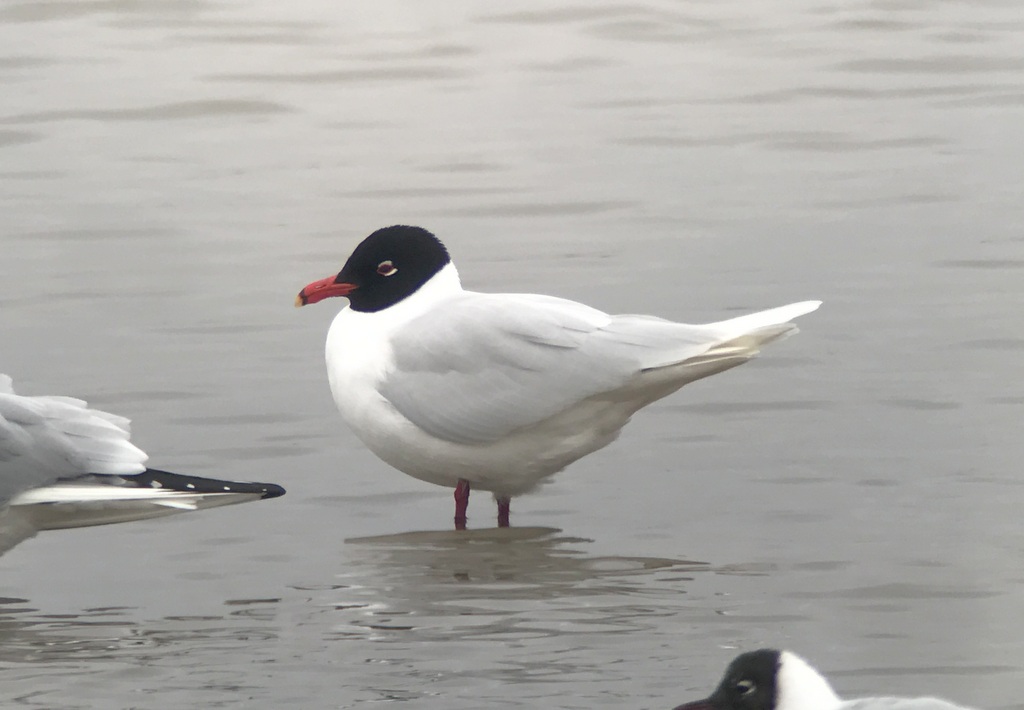
There were a few more waders on the Volunteer Marsh – several Avocets, a couple of Grey Plover, plus one or two Black-tailed Godwits and Curlew. The deeper channel at the far side held more of the same, plus a couple of little groups of Knot.
The tidal pools are flooded at the moment, so we headed straight on to the beach. The tide was out but we could immediately see that most of the waders were out here. There were lots of Knot and Dunlin in big flocks and several Bar-tailed Godwits too, all feeding on the edge of the water. We managed to spot three Sanderlings running in and out in front of the waves, until they flew off east.
Looking out to sea, it was very misty and hard to see too far. We did manage to find a few things on the water. There were good numbers of Red-breasted Merganser close inshore and a couple of Common Scoter were with them. A Great Crested Grebe was out on the edge of the mist, but the highlight was a Slavonian Grebe close inshore, though it was diving constantly and making its way quickly east towards Brancaster.
It was time to head back, as we still had one last stop we wanted to make today. As we headed inland, up towards Choseley, a Barn Owl was already out hunting. They have been much more visible in recent weeks, presumably being much more hungry now after the snow.
On our way home, we diverted round via Bintree Mill. There were lots of ducks on the large pool nearby – Shoveler, Gadwall, Teal and a small number of Wigeon too. A drake Garganey had been seen here a couple of days ago and had been refound here again this morning. After a bit of scanning, we managed to locate it, upending constantly, hiding in the vegetation.
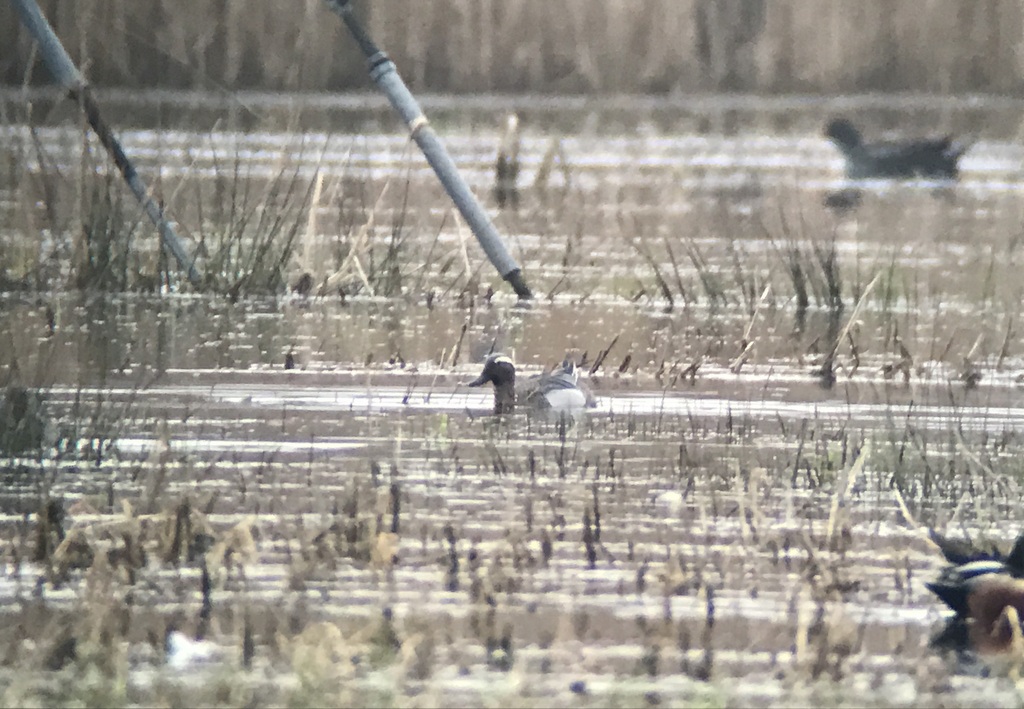
We had a good view of the drake Garganey through the scope, we could see its striking white supercilium and elongate scapular plumes. It was a nice way to end the day, with a proper summer migrant. And it was not far back home so we made it in good time for tea & cake!
















